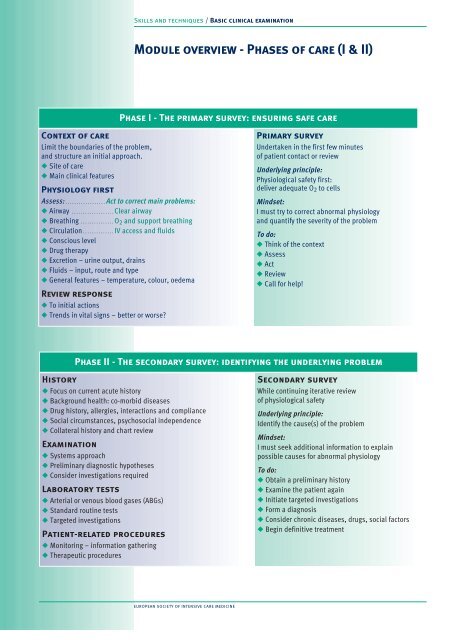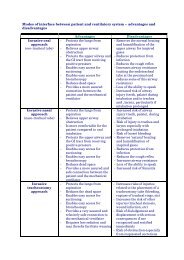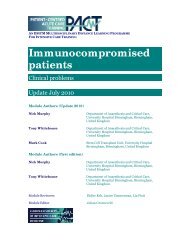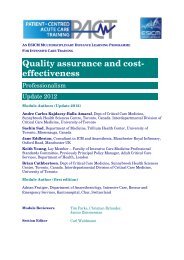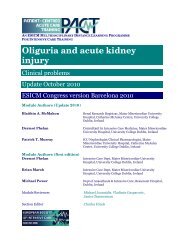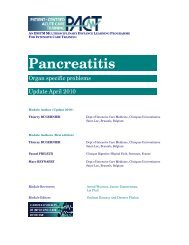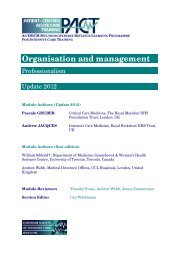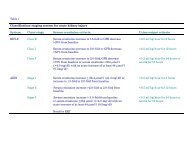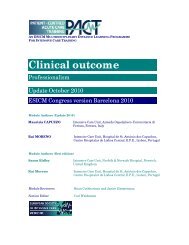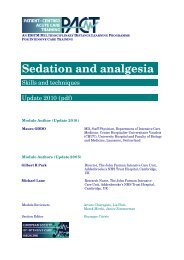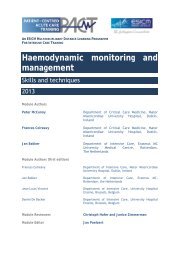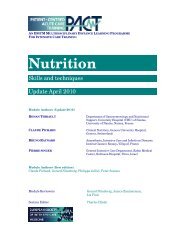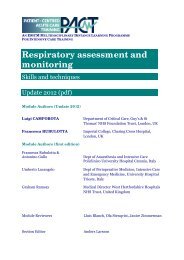Module overview - Phases of care (I & II) - PACT
Module overview - Phases of care (I & II) - PACT
Module overview - Phases of care (I & II) - PACT
You also want an ePaper? Increase the reach of your titles
YUMPU automatically turns print PDFs into web optimized ePapers that Google loves.
Skills and techniques / Basic clinical examination<strong>Module</strong> <strong>overview</strong> - <strong>Phases</strong> <strong>of</strong> <strong>care</strong> (I & <strong>II</strong>)Phase I - The primary survey: ensuring safe <strong>care</strong>Context <strong>of</strong> <strong>care</strong>Limit the boundaries <strong>of</strong> the problem,and structure an initial approach.◆ Site <strong>of</strong> <strong>care</strong>◆ Main clinical featuresPhysiology firstAssess: . . . . . . . . . . . . . . . . . . Act to correct main problems:◆ Airway . . . . . . . . . . . . . . . . . . . Clear airway◆ Breathing . . . . . . . . . . . . . . . O 2 and support breathing◆ Circulation . . . . . . . . . . . . . . IV access and fluids◆ Conscious level◆ Drug therapy◆ Excretion – urine output, drains◆ Fluids – input, route and type◆ General features – temperature, colour, oedemaReview response◆ To initial actions◆ Trends in vital signs – better or worse?Primary surveyUndertaken in the first few minutes<strong>of</strong> patient contact or reviewUnderlying principle:Physiological safety first:deliver adequate O 2 to cellsMindset:I must try to correct abnormal physiologyand quantify the severity <strong>of</strong> the problemTo do:◆ Think <strong>of</strong> the context◆ Assess◆ Act◆ Review◆ Call for help!Phase <strong>II</strong> - The secondary survey: identifying the underlying problemHistory◆ Focus on current acute history◆ Background health: co-morbid diseases◆ Drug history, allergies, interactions and compliance◆ Social circumstances, psychosocial independence◆ Collateral history and chart reviewExamination◆ Systems approach◆ Preliminary diagnostic hypotheses◆ Consider investigations requiredLaboratory tests◆ Arterial or venous blood gases (ABGs)◆ Standard routine tests◆ Targeted investigationsPatient-related procedures◆ Monitoring – information gathering◆ Therapeutic proceduresSecondary surveyWhile continuing iterative review<strong>of</strong> physiological safetyUnderlying principle:Identify the cause(s) <strong>of</strong> the problemMindset:I must seek additional information to explainpossible causes for abnormal physiologyTo do:◆ Obtain a preliminary history◆ Examine the patient again◆ Initiate targeted investigations◆ Form a diagnosis◆ Consider chronic diseases, drugs, social factors◆ Begin definitive treatmentEUROPEAN SOCIETY OF INTENSIVE CARE MEDICINE
Skills and techniques / Basic clinical examination<strong>Module</strong> <strong>overview</strong> - <strong>Phases</strong> <strong>of</strong> <strong>care</strong> (<strong>II</strong>I & IV)Phase <strong>II</strong>I - The tertiary survey: integration; turning data into effective actionMaking a diagnosis◆ Managing data◆ Linking clinical and laboratory information◆ Revising probabilitiesTreatment: planning,monitoring andreviewing responses◆ Problem-oriented analysis◆ Causation◆ Therapeutic goals◆ Preventative measures◆ Site <strong>of</strong> <strong>care</strong>◆ Patient-centred outcomes◆ Assessment <strong>of</strong> severity <strong>of</strong> illnessand physiological reserveTertiary surveyWhile continuing iterative review <strong>of</strong> physiological safetyUnderlying principle:Plan the right treatment for this patientMindset:I must provide safe and effective treatment in accordancewith patient’s known or presumed wishesTo do:◆ Re-check the findings from the secondary survey◆ Single or multiple organ problem?◆ Choose safest environment for <strong>care</strong> delivery◆ Evaluate patient response to treatment◆ Obtain more detailed history using various sourcesPhase IV - Continuing <strong>care</strong>: systems managementTeamwork◆ General principles◆ Communication skills◆ Managing dissent and conflictDocumentation◆ Record keeping◆ Electronic methods <strong>of</strong> information managementContinuing <strong>care</strong>Underlying principle:Safe <strong>care</strong> requires coordinated input from many peopleworking effectively togetherMindset:I must work with all members <strong>of</strong> the multidisciplinary teamto avoid gaps, discontinuities and conflictsTo do:◆ Team management◆ Communication – a two-way process◆ Support, empower team members througheffective information◆ Clear treatment plan◆ Clear documentationEUROPEAN SOCIETY OF INTENSIVE CARE MEDICINE


